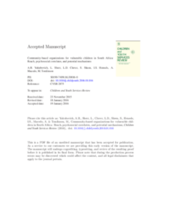Community-based organizations (CBOs) have the potential to provide high quality services for orphaned and vulnerable children in resource-limited settings. However, evidence is lacking as to whether CBOs are reaching those who are most vulnerable, whether attending these organizations is associated with greater psychosocial wellbeing for the individual, and how CBOs work in practice. This study addressed these questions using cross-sectional data from 1,848 South African children aged 9-13. Data were obtained from the Young Carers and Child Community Care studies, which both investigated child wellbeing in South Africa using standardized self-report measures. Children from the Child Community Care study were all CBO attenders, whereas children from Young Carers were not receiving any CBO services, thereby serving as a comparison group. Multivariable regression analyses were used to test whether children attending CBOs were more deprived on socio-demographic variables (e.g., housing), and whether CBO attendance was in turn associated with better psychosocial outcomes (e.g., child depression).
The results showed that the children attending CBOs did qualify as being more vulnerable based on most sociodemographic variables. For example, compared to children not attending any CBO, CBO-attending children tended to live in more crowded households (OR 1.22) and have been exposed to more community violence (OR 2.06). However, despite their heightened vulnerability, children attending CBOs tended to perform better on psychosocial measures. They showed fewer depressive symptoms (B=-0.33) and lower odds of experiencing physical (OR 0.07) or emotional abuse (OR 0.22). Indirect effects of CBO attendance on better child psychological wellbeing (lower depressive symptoms) was observed via lower rates of child abuse (B=-0.07) and domestic conflict/violence (B=-0.03) and higher rates of parental praise (B=-0.03).
Importantly, the study also tested to see whether the relationship between CBO attendance and improved psychological wellbeing was mediated by a more positive family home environment. The results indicate that the relationship is mediated by certain family characteristics, including lower rates of physical or emotional child abuse (B = − 0.07), lower rates of domestic violence/conflict (B = − 0.03), and higher rates of parental praise (B = − 0.03). Thus, this emphasizes the importance of family attendance at CBOs, bolstering arguments for a family-centred approach to alleviating child vulnerability.
It is also important to note that this study did not find evidence that CBOs are associated with improvements on more severe psychological outcomes such as child trauma and suicidal ideation, suggesting that more intensive psychosocial services are required to reduce these conditions, for which CBOs may not have the specialized training or skills.
In sum, this study provides promising evidence regarding the potential success of CBOs on the lives of vulnerable young people in resource-limited settings such as South Africa. It is an important "real-world" investigation into how CBOs work in practice. It demonstrates that CBOs are targeting the most vulnerable children, and they appear to be associated with improved psychological outcomes for these children.

